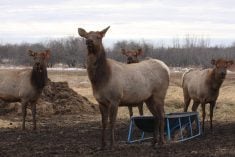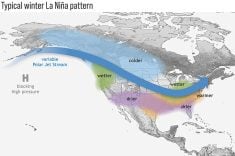There was likely a collective gasp across the Prairies during a recent episode of CBC Television’s Dragons’ Den when two dragons said they had never heard of saskatoon berries.
But that’s exactly why Sandra Purdy, co-owner of Prairie Berries at Keeler, Sask., approached the potential investors.
The fruit is not widely known outside the West yet that’s where future markets are.
Purdy appeared on the Oct. 13 episode of the popular show featuring five Canadian investors who listen to pitches and decide whether to invest in the businesses.
Read Also

Canadian Food Inspection Agency extends chronic wasting disease control program consultation deadline
Date extended for consultation period of changes to CWD program
She asked for $250,000 in exchange for 49.9 percent of the company.
She wanted $120,000 for marketing, $80,000 for a resource person and $50,000 to lease equipment.
She left with a handshake with Arlene Dickinson, president of Calgary-based Venture Communications, for that amount, plus a 10 percent royalty on sales greater than the 181,000 kilograms Prairie Berries is currently selling.
“You are absolutely at the tipping point of where the industry is headed and what people want,” Dickinson said. “They want this.”
Purdy’s niece, Allison Ozog, a graduate student at the University of Saskatchewan, spoke of the health benefits of the berries.
Purdy said the deal has not yet been finalized but she believed it would be.
“There is nothing inked at this point in time,” she said Oct. 19, adding that she and Dickinson had discussed the deal that day. “In my opinion, it’s going forward.”
Prairie Berries, formed by Purdy and her husband, Ken, in 1996, is the world’s largest producer and processor of saskatoons in the world, with sales last year of about $389,000. Still, Purdy told the dragons she had a loss of $64,000.
Two dragons, Kevin O’Leary and Robert Herjavec, said they had not heard of the berry and she had a marketing nightmare on her hands.
“This is a horrible challenge. You need millions of dollars,” said O’Leary during the show.
The Prairie-born dragons – Jim Treliving, Brett Wilson and Dickinson – knew all about saskatoons but Treliving also thought more money would be needed to crack the market.
“I think you can ignore the two city boys. They don’t get out much,” Wilson quipped.
At the same time, he said he wouldn’t invest because he felt the industry should take more responsibility for raising its profile.
Purdy and several other growers launched the Sask-atoon Berry Council of Canada in March 2009 and this summer embarked on an aggressive membership drive.
There are about 900 growers producing 2.9 million kg, according to 2006 statistics, and probably more growers who don’t report small acreages.
“By 2014, we believe production is going to double,” she said.
Someone needs to pull those berries through the production chain and sell them around the world.
Purdy, who is council president, said growers and processors have to work together to promote the industry.
Pooling their resources allows them to get more bang for their promotional bucks.
They also must educate consumers about the nutritional properties.
Saskatoons are high in antioxidants and should be considered among other “super fruits” such as blueberries, cranberries and pomegranates, she said.
Prairie Berries already supplies fruit to Dairyland for yogurt and is working on a deal with a juice maker.
When Purdy talks about Prairie Berries becoming the next Ocean Spray, she’s not kidding. Three cranberry growers started that company and cranberries have become much more than an accompaniment for turkey dinner.
She added that giving up nearly half of the company to an outside investor wasn’t that difficult.
Having half a company that is worth millions is better than owning all of a company worth much less, she said.
The Purdys had already leveraged as much debt as they could but needed more money to take the company further.
ApproachingDragons’ Denwas perhaps a “crazy idea”, she said. But even if she had left empty-handed, the exposure on national television would have been worth it.
Stuff about saskatoons
•The saskatoon berry is also called serviceberry, sarvisberry or juneberry.
•The fruit is high in antioxidants, which help improve the immune system.
•First Nations used saskatoon berry juice to relieve upset stomachs and green or dried berries were used to make eyedrops. A tea was made to prevent miscarriage.
•Saskatoons were also used by First Nations to make pemmican. The berries were pounded into buffalo meat to create dried meat similar to beef jerky.
•The hard, strong branches of the shrub were used to make arrows. fishing rods and tool handles.















